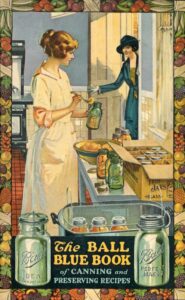
Almost everybody in Appalachia has a home canning story. Whether it’s that jar of pickles that just didn’t keep its crunch, or the homemade apple butter with that heavenly taste, or the month canning went awry when several jars burst, and so forth. And I’d go even further to say everyone has a home canning story associated with an ancestor.
I have several memories. My great aunt Gladys’s bread and butter pickles were such a yummy treat. My mother made an incredible blackberry jelly and sealed it with parafin wax because we couldn’t afford lids and bands. She told me stories of how my great grandmother Goins canned jelly without pectin or sugar – and it was “the best, sweetest jelly” she’d ever had in her life.
Today, my aunt makes amazing jellies from just about any fruit. Her pickles, green beans, and pickled okra are filled with seasons. And don’t get me started on my sister-in-law, who I consider the consumate home canner. Everything – and I mean everything – she cans is just to die for. And she learned from her mother, deep in Kentucky’s blue hills and mountains. These are just a few delicious memories and beautiful associations.
So far this year, our three tomato plants have yielded about a bushel of tomatoes (!), from which we have canned salsa, stewed tomatoes, and taco sauce. We also canned a small batch of applesauce. Join us here for our venture in canning salsa.
Delonda Anderson, Chief Editor
__________
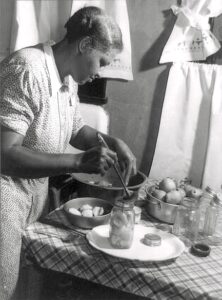
A general note on this salsa recipe, and recipes for canning in general. In short, it’s a process about volume and the recipes reflect that. They refer to cups or pounds of the base ingredient, in this case tomatoes, and the ingredient measurements are set in proportion to that. In practice it’s a game of estimates. How many cups will our garden tomatoes (or apples, or whatever) actually yield? Even store-bought bags of produce that list a specific weight vary when peeled, cored, and cut. So, like the best recipes we learned from our elders, the measurements are more guidelines than rules, and the best way to know you’ve got it right, is to taste. After all, one person’s pinch, is another person’s dollop. On with the recipe!
Tom Anderson, Admin
__________
Did You Know?
Napoleon Bonaparte is considered the “father of canning.” He offered a substantial amount of money (equalling about $45,000 in today’s USD) to anyone who created a system to keep military food from spoiling. The winner was Chef Nicholas Appert who “invented the process of packing meat and poultry in glass bottles, corking them, and submerging them in boiling water.”1)U.S. Department of Agriculture Unbeknownst to him, the method sterilized the food, stopping bacteria growth. Canning was born!
__________
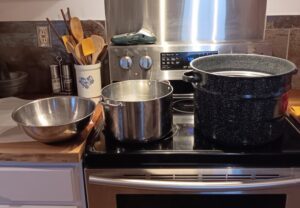
For starters, you’ll need:
- Water bath canner with rack
- Canning jars
- Lids
- Bands
- Head space measurer/ bubble remover
- Canning funnel
- Magnetic stick
- Jar remover/ grabber
Ingredients:
- 7 – 8 lbs tomatoes2)We had 44 – 45 mid-sized tomatoes –– cored, blanched, peeled, chopped
- 2 green bell peppers –– seeded, chopped
- 1 lg cucumber –– peeled, seeded, chopped
- 2 – 3 green onions –– sliced
- 1 red onion –– peeled, chopped
- 2 C banana peppers –– seeded, chopped
- 4 jalapeno peppers –– seeded, chopped
- 3 jalapeno peppers –– unseeded, chopped
- 1 cup cider vinegar
- 4 – 5 cloves garlic –– minced
- ½ bunch cilantro3)Most recipes call for 1 to 2 T of chopped cilantro. Some of us really love the taste of cilantro, hence a lot of the herb was used here. No true grey area seems to exist regarding the taste of this herb. People either love it or hate it. Many people who don’t like cilantro say it tastes like dish liquid. –– chopped
- 1 ½ tsp salt
- 1 tsp hot pepper sauce4)We used Louisiana Hot Sauce.
- 1 T Italian seasoning
- 2 T lime juice
- ½ tsp ground cumin
Steps5)To follow this recipe, please remember to always take CAUTION whenever cooking with HIGH heat, SCALDING water, and STEAM. Appalachia Bare cares so much for our readers, but we have no responsibility for any boo-boos, owies, or umphs.
- First, determine the number of quarter pint, half pint, pint, or quart jars you will need. Volume estimates are included in most canning recipes.
- Inspect jars for cracks or other damages. Wash jars, lids, and bands in warm, soapy water. Lids must be new and unused. Bands can be re-used, but check and make sure they aren’t grody.
- Blanch tomatoes. Blanching the tomatoes makes peeling them so much easier. Here’s our process:
- Fill a large bowl with cold ice water. Set aside.
- Bring large pot of water to a boil. Add cored tomatoes to boiling water.6)Be careful, here! Wear gloves. Boil 2 minutes.
- Quickly transfer tomatoes to ice water bath to cool them down and stop the cooking process. (You may need to work with two or three batches.)
- Peel tomatoes. Chop tomatoes and add to pot to make salsa.
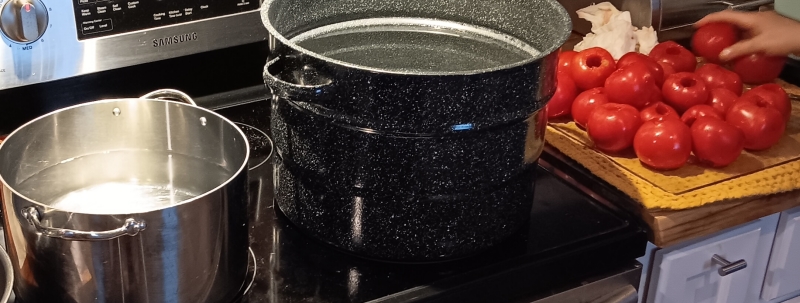
4. Two processes are a little simultaneous. One must prepare the hot food to add to the hot jars.
-
- Prepare the heated salsa. Mix all ingredients in large pot. Bring to a boil, then reduce heat to a simmer. Stir occasionally. Keep simmering.
- Heat the jars to prevent cracking. Heat the lids to provide the seal. Fill the canner and heat until water reaches 180°F. Maintain that temperature. Place canner rack above the water. Place empty jars on rack and lower.7)Be careful with hot water and steam! Wear gloves and protective gear. Make sure water covers the jars. If not, add hot water until jars are submerged. Drop lids into hot water. Heat jars and lids for 10 minutes.
- Lift jars on the rack.
5. Add the heated salsa to each jar,8)CAUTION! Watch out for hot spatters. leaving ½ inch headspace. Wipe rim clean. Remove each lid with magnetic stick and place atop jar. Screw on bands and tighten.
6. Place each jar on lifted rack with space in between and not touching. Lower jars into water. Bring to a rolling boil. Cover and process for 15 minutes.
7. After 15 minutes, uncover, lift rack, and allow the canner to sit 5 minutes.
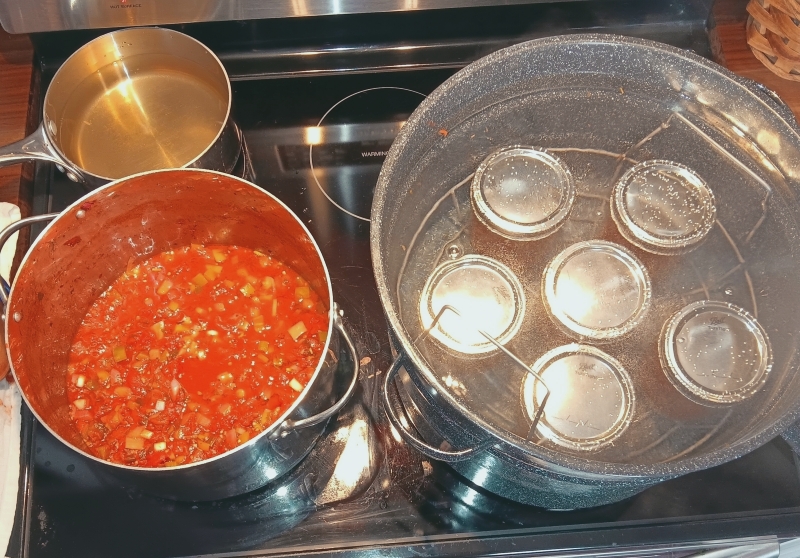
8. Remove jars to a secure place, free from bumps and movement. Let sit for 24 hours, checking lids for seal. DO NOT PRESS ON LIDS. Doing so ruins the vacuum seal. Usually, one hears a “ping” or “poink” sound when the seal has vacuumed.
9. According to the USDA, use within 1 year. Other sources say home canned foods last indefinitely, but lose quality each year.
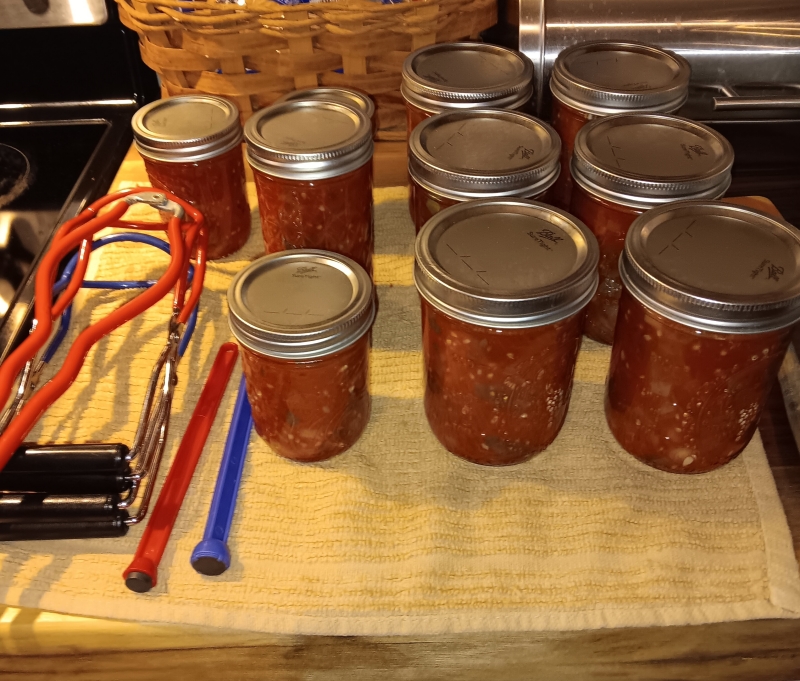
**Featured image: Keverne Denahan – Pexels
References
| ↑1 | U.S. Department of Agriculture |
|---|---|
| ↑2 | We had 44 – 45 mid-sized tomatoes |
| ↑3 | Most recipes call for 1 to 2 T of chopped cilantro. Some of us really love the taste of cilantro, hence a lot of the herb was used here. No true grey area seems to exist regarding the taste of this herb. People either love it or hate it. Many people who don’t like cilantro say it tastes like dish liquid. |
| ↑4 | We used Louisiana Hot Sauce. |
| ↑5 | To follow this recipe, please remember to always take CAUTION whenever cooking with HIGH heat, SCALDING water, and STEAM. Appalachia Bare cares so much for our readers, but we have no responsibility for any boo-boos, owies, or umphs. |
| ↑6 | Be careful, here! Wear gloves. |
| ↑7 | Be careful with hot water and steam! Wear gloves and protective gear. |
| ↑8 | CAUTION! Watch out for hot spatters. |
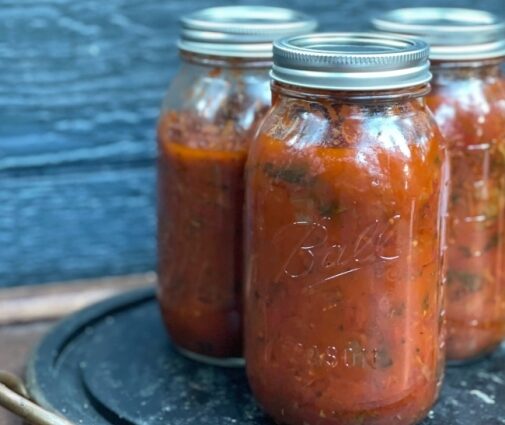
My Grandma Long canned apple butter, among other things. I used to look forward to Sunday suppers where we’d slather the apple butter on homemade biscuits. I can still smell that sweet odor after all these years! It’s nice that you’re continuing this Appalachian tradition!
Brings back some great memories of strawberry jam and canned veggies from the garden in Oregon and spending time together in our own kitchen making jams, applesauce, apple butter and, my favorite, canning fresh peaches. Oh my, so good, we ate them for dessert. No tomatoes or salsa though, it was all about the sweet tooth! And also, great job with your instructions and photos.
I’d love to hear more of your stories about canning, Peg.